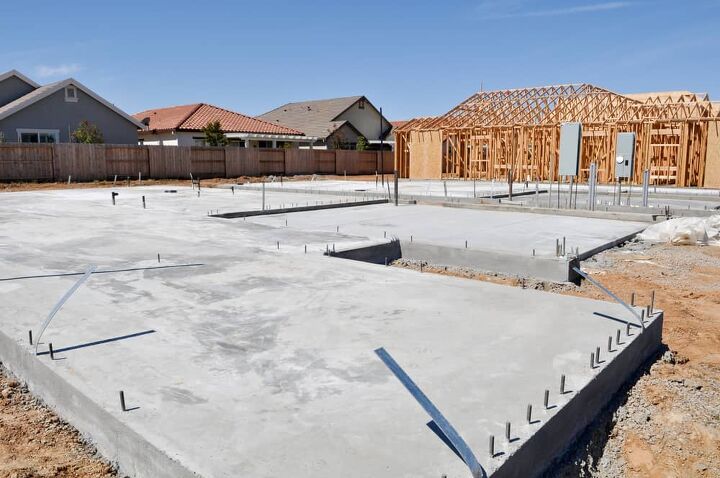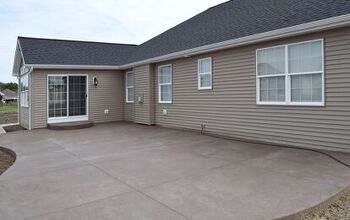Wood Foundation Vs. Concrete: What Are The Major Differences?

The foundation of a building is important for a lot of reasons. Without it, the house cannot safely remain upright, especially in the face of severe weather or slight shifts in the ground. That is why having a solid foundation in place is so imperative.
The two most common options are concrete slab and wood. But what are the differences? Concrete is cheaper and combats humidity much better. Wood is easier to install and provides greater accessibility to piping and wiring. Both have their own inherent set of benefits and downsides.
With that said, let’s dive in and take a deeper look at wood foundation vs. concrete to obtain a better understand as to which option is ideal for your purposes.
Concrete Foundations
There are two methods for laying a concrete foundation: pouring into a solid wall or laying blocks. About 2/3rds of all foundations are poured. It’s more durable for below-ground use and concrete is both readily available and affordable.
Concrete is great at resisting water intrusion, too. If you live in areas prone to high water, concrete may be the best choice. It is far less flexible than wood, however, and is prone to cracking. Concrete bricks are less common these days because improper installations can lead to water intrusion and structural movement.
Wood Foundations
While the name may be a little misleading, a wood foundation, or permanent wood foundation (PWF) is not made entirely out of wood. In fact, only the below-grade foundation walls of a wood foundation are constructed out of wood. These foundations typically have a concrete slab base, which rests atop a bed of crushed gravel or rock.
This type of foundation consists of wood that has already been pressured treated with chromated copper arsenate (CCA). The copper component of this treatment protects against mold, rot and fungus, while the arsenate helps repel termites, ants, and other pests. Wood foundations do a much better job of controlling and managing temperature, creating warmer basement spaces in cold weather.
They are also better when it comes to accessing piping or wiring for repair. That said, they tend to be more susceptible to water damage, mold especially. Those with wood foundations will need to be more diligent about protecting against water damage.
The Pros of a Concrete Foundation
Concrete foundations are quite common for a reason. A few reasons, actually. Concrete foundations are typically in place of a basement foundation or crawl space. There are a few major benefits to going with a concrete foundation, particularly over wood.
Affordability
Perhaps the biggest reason to go with a slabbed concrete foundation is due to the costs. Laying the foundation for a home can get expensive quickly. For other options, the costs can escalate quickly. There is more digging, cement footers need to be installed, and so on.
Concrete also minimizes how much concrete gets poured. It is not uncommon for a concrete foundation to cost thousands less than some of the alternatives out there. Look at the 5 best concrete densifiers to fortify your foundation.
Little to No Humidity
When it comes to basements and foundations, moisture is a major issue. Since the foundation is underground, there is an increased issue with humidity and moisture. It is not uncommon for mold to appear in some foundations.
With concrete slab foundations, this problem becomes a thing of the past. The concrete eliminates humidity and the possibility for mold growth. Given the health issues that can arise from mold infestations, that is a major benefit.
Lower Ground Level
With crawl space foundations and basements, in particular, they are elevated off of the ground. That’s to make for the additional space required for those foundations. That requires stairs or ramps to be built on the exterior to accommodate.
For those living with handicaps, that can present accessibility issues. When you have a concrete foundation, that issue is eliminated. Something to consider for those with mobility issues.
The Cons of a Concrete Foundation
For all of the benefits to be had by using a concrete foundation, there are downsides to be had as well. These should be considered when making your choice between wood and concrete slab foundations. Chief among them are lost storage space and wiring/plumbing accessibility issues.
Less Storage Space
Perhaps the biggest downside to a concrete foundation is the potentially lost storage space. A basement or crawl space presents a lot of additional storage space, particularly if there is not a garage on the property as well.
With a concrete foundation, there is no hiding the home amenities in a basement. Water heaters, washers, dryers, etc. all need to go somewhere else. That can create some logistical problems that other foundations may not.
Trouble Accessing Wiring and Plumbing
Houses built on a concrete slab have to incorporate things like wiring, piping, and heating ductwork right into the foundation. Should those things ever need access, it can be quite a difficult task regardless of the professional involved.
Any accessibility issues could lead to substantially higher repair costs when using a contractor. Moreover, it limits the potential for DIY repairs because getting to the wiring and plumbing can be so difficult.
Hard Surface Flooring
When you have a cement foundation, that means cement flooring on the ground floor of the home or building. There is no flex to cement like there is with a wood framework used in basements and crawl spaces.
Because there is no flex or give, cement flooring can prove to be straining on knees and feet over time. You can install carpeting and other soft materials to combat this, but that comes with an additional cost.
The Pros of a Wood Foundation
Just like concrete foundations, there are plenty of inherent benefits to going with a wood foundation. While wood foundations remain somewhat uncommon, they tend to be easier to install, provide better accessibility for repair purposes, are the much greener choice of the two, and are best suited for hard-to-reach building sites.
Easier to Install
Compared to a concrete foundation, wood foundations are much easier to install. The crew that builds the framing for the house can also build the wooden foundation. That means a far more expedited installation than concrete slabs.
When it comes to new home construction, it can be easy to get off schedule. Having a wooden foundation is a great way to trim down some of that timeline and ensure that the foundation of the home is in place and secure.
Greener Choice
As permanent wood foundations are constructed of a renewable resource – wood – they are, arguably, the greener choice when it comes to wood foundations vs. concrete. Though, there are some potential environmental dangers associated with the chemicals that go into the pressure treatment process.
Easier Repair Access
Sooner or later, every home needs to have plumbing, electrical, or both done. With a concrete foundation, accessing those lines can become a great point of difficulty. A wooden foundation means fewer obstacles standing between the repairperson and a fix.
Better Insulation
Concrete foundations also tend to struggle with heating and cooling. It is far less efficient than wooden foundations. With wood foundations, the basement is typically a little lower, especially during the cooler months of the year.
If you are looking to lower energy costs, a wood foundation is a great way to do so. Plus, you can always add insulation or swap it out for a more efficient option later on down the line.
Ideal for Remote Locations
Wood foundations tend to be the ideal choice for homes and other structures located in hard-to-reach areas. Transporting poured concrete or concrete block foundations to remote locations is, oftentimes, nearly impossible. This is where a wood foundation can really come in handy!
Not to mention, should the homeowner decide to switch up their floor plan later on down the line, a wooden foundation is much easier to move than a concrete one. So, overall, permanent wooden foundations offer more flexibility.
The Cons of a Wood Foundation
The downsides are there for wood foundations as well. On the whole, it is more expensive to install a wood foundation. Moreover, wood foundations are much more susceptible to water invasion than concrete is. Here are some of the most notable cons.
Higher Costs
Concrete is cheaper and more readily available than wood. If you plan to have a wood foundation installed, expect to pay substantially more than you would going with a concrete foundation. There are costs saved later on, but that initial investment is nothing to ignore.
Toxicity of Materials
There are certain chemicals that go into pressure-treating the wood for this use. Those chemicals mean wearing protective gear for the duration of the construction. Furthermore, there may be possible environmental and health dangers associated with the pressure-treated wood.
Susceptible to Rot
When the concrete is laid, nothing is wearing it down. The same can’t be said for wood. Even pressure-treated wood is susceptible to rot and attack from insects. If either of those issues occur, having to replace large portions of the foundation can add up quickly.
Not the Norm
Although there are hundreds of thousands of homes in the United States constructed with wood foundations, concrete foundations, whether they’re made out of blocks or poured, continue to be the norm.
Homeowners with wood foundations may face skepticism and some extra hurdles from realtors and home inspectors when it comes time to sell their home. They may also face some challenges when getting their home insured. So, this is certainly something to consider.
Wood vs. Concrete Foundation: What’s The Better Choice?
The short answer is “it depends.” Each has its own distinct set of advantages and disadvantages that location becomes important. For areas with a lot of rain, concrete foundations are probably the better choice given their resistance to water intrusion. Wood tends to be more flexible and accessible when it comes to repairs.
The fact of the matter is that either is a fine option. Those valuing more storage or living space would probably be better served by a wood foundation/basement. Those living in areas with heavy humidity, though, may find that a concrete foundation keeps mold away far better. It really comes down to preference.
Related Articles

Ryan Womeldorf has more than a decade of experience writing. He loves to blog about construction, plumbing, and other home topics. Ryan also loves hockey and a lifelong Buffalo sports fan.
More by Ryan Womeldorf



















![12 Washing Machine Brands to Avoid [with Recall Data]](https://cdn-fastly.upgradedhome.com/media/2023/07/31/9075781/12-washing-machine-brands-to-avoid-with-recall-data.jpg?size=350x220)







